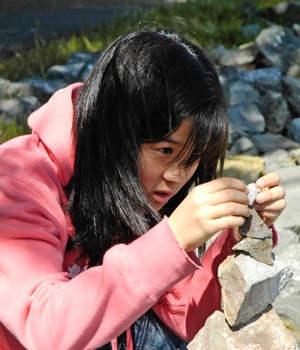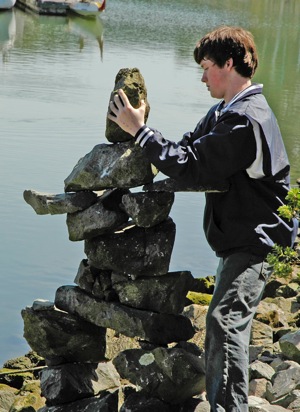
“I NEVER thought I could do that!”
Zach Pine has heard that exclamation many times in his work as an informal educator. Not surprising, since Pine continually challenges both children and adults to succeed at something they thought was impossible. What challenge does Pine present his learners? To balance rocks of all shapes and sizes, one atop another in a free form sculpture, without any other means of support like sticks, clamps, or glue.
“When I first introduce this activity, people instinctively say ‘But that’s defying the laws of gravity!’ My answer is that rock balancing is actually using the laws of gravity, and I can teach them how.”
The “secret” Pine teaches is finding each rock’s center of gravity and its “tripod”—a physical point on the rock that helps it stay stable and not tip over. He has seen even the most hesitant hands-on learners quickly progress from simple trial and error to making educated guesses. “As they’re sculpting,” he says, “they don’t even realize they’re immersed in the scientific process of making a hypothesis, testing it, finding results, revising their hypothesis, and testing it again and again and again...In creating a balanced rock sculpture, you are truly conducting many little experiments.”
Pine has found that many kids have no previous experience with real rocks. “They get hold of them and then treat them as though they are ‘virtual rocks’ in an online game. They don’t know how actual objects behave. That’s a powerful insight, and it has to come from hands-on experience,” he emphasizes.
Handling rocks helps learners discover not only each stone’s center of gravity, but their own. Trained as a physician, Pine has seen both boys and girls draw from rock balancing a sense of confidence and an understanding of the physics and mechanics of their own body and skeleton. “When you do this activity, you actually feel more rocklike!” he says.
Leading nature activities like rock balancing doesn't require a degree in medicine or physics, Pine emphasizes. And though he encourages educators to use the backdrop of an outdoor nature area, he emphasizes that tactile experiences with nature can inspire children in any setting including a classroom or a home kitchen. “The most important thing is to provide natural materials, like rocks, twigs, leaves, or pinecones, then invite and permit learners to be creative and playful. No matter where they live or learn,” he says, “everyone has a connection with nature.”
You can find additional balancing activities in the howtosmile.org collection, including:
—Take if from the Top
—Building With Wonderful Junk
—Set It Straight and
—Fork It Over: Find the Center of Gravity
